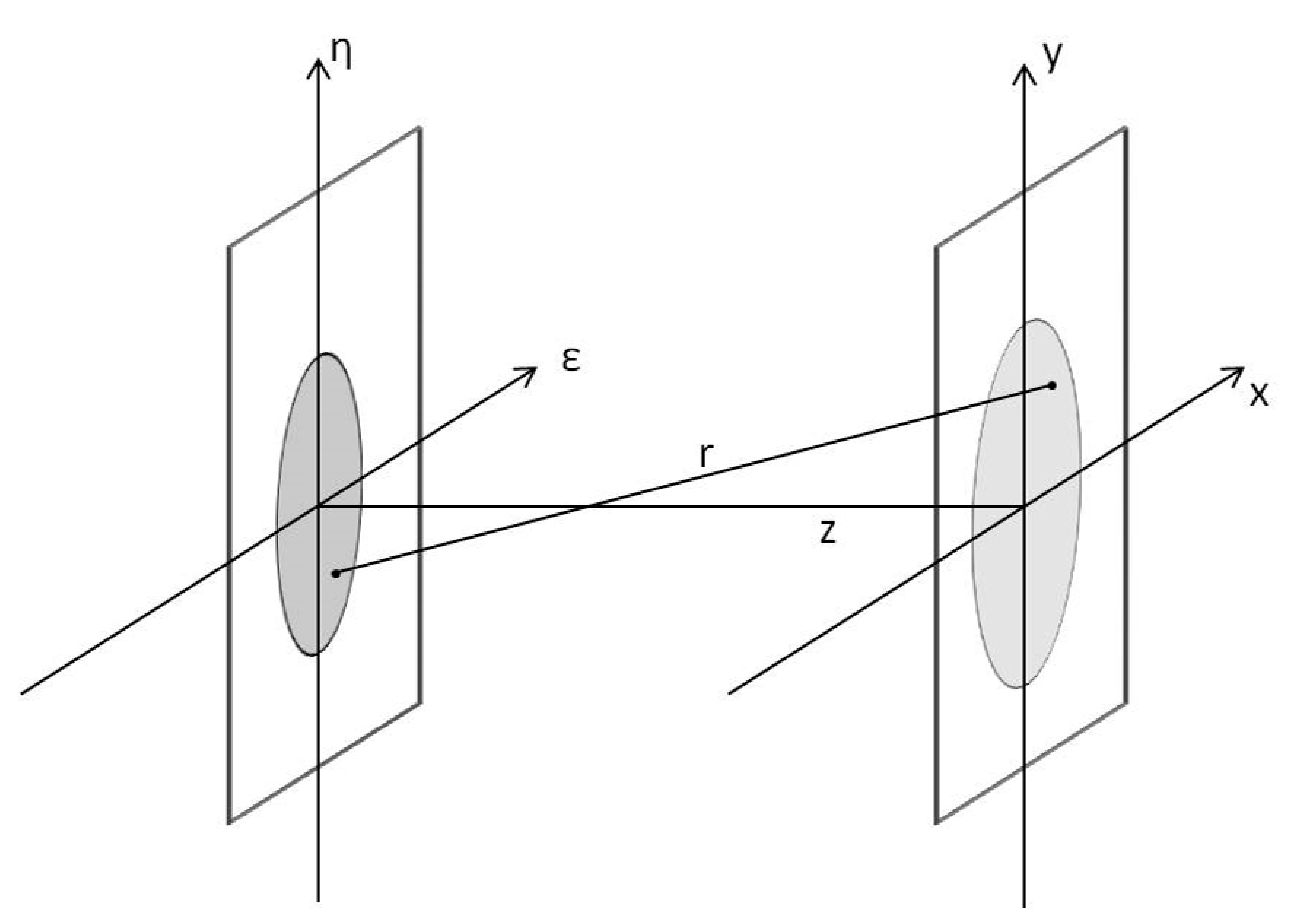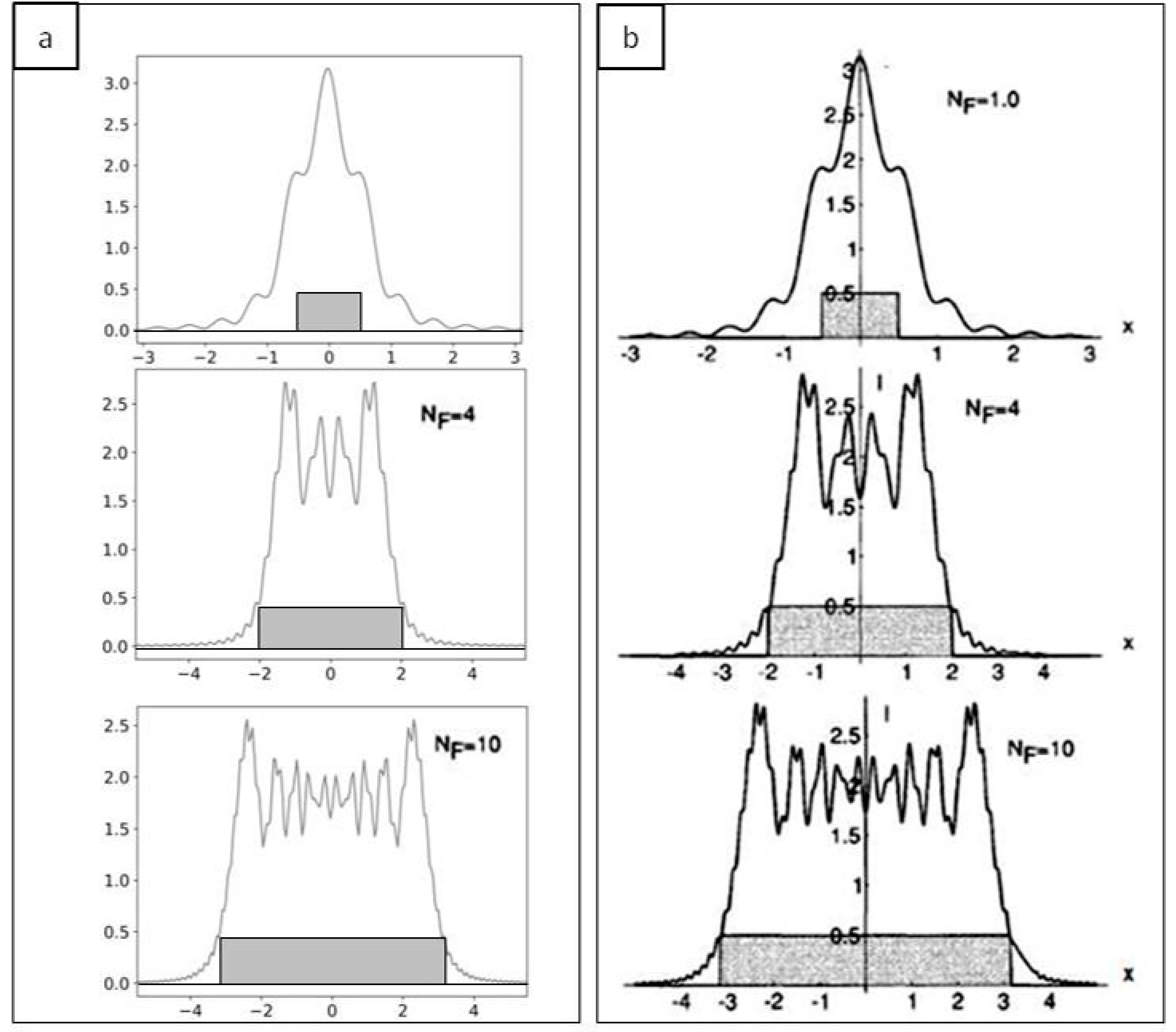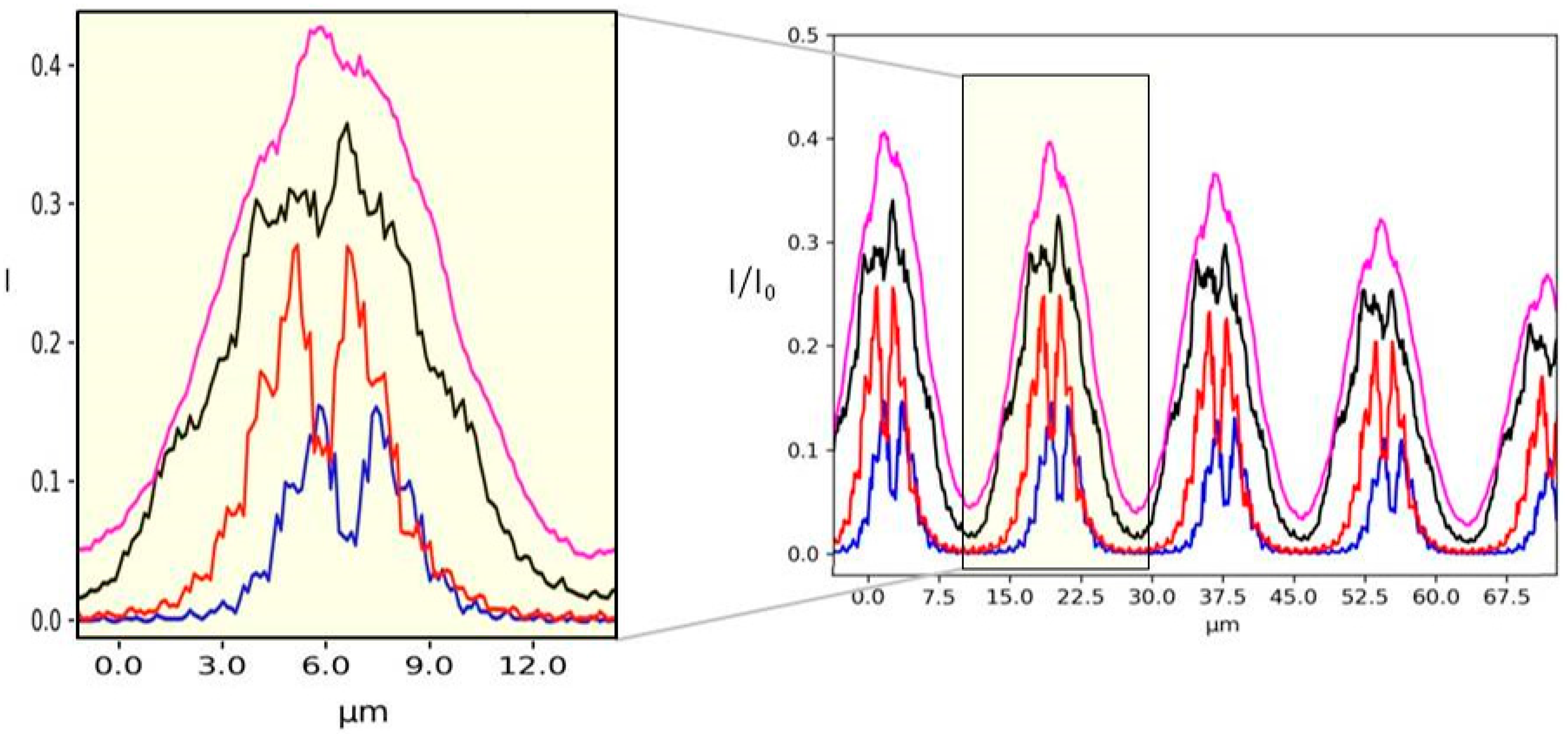Modelling of Phase Contrast Imaging with X-ray Wavefront Sensor and Partial Coherence Beams
Abstract
:1. Introduction
2. Materials and Methods
2.1. Fresnel Propagator
2.2. Propagator Validation
2.3. Source Coherence
2.4. Computational Details
3. Results and Discussion
3.1. Diffraction from a Test Object
3.2. Imaging with Very Compact Hartmann Sensor
3.3. Imaging with Standard Hard X-ray Hartmann Sensors
3.4. Talbot Effect
4. Conclusions
Author Contributions
Funding
Conflicts of Interest
References
- Fratini, M.; Bukreeva, I.N.; Campi, G.; Brun, F.; Tromba, G.; Modregger, P.; Bucci, D.; Battaglia, G.; Spanò, R.; Mastrogiacomo, M.; et al. Simultaneous submicrometric 3D imaging of the micro-vascular network and the neuronal system in a mouse spinal cord. Sci. Rep. 2015, 5, 8514. [Google Scholar] [CrossRef]
- Olivo, A.; Bohndiek, S.E.; Griffiths, J.A.; Konstantinidis, A.; Speller, R.D. A non-free-space propagation x-ray phase contrast imaging method sensitive to phase effects in two directions simultaneously. Appl. Phys. Lett. 2009, 94, 044108. [Google Scholar] [CrossRef]
- Flenner, S.; Storm, M.; Kubec, A.; Longo, E.; Döring, F.; Pelt, D.M.; David, C.; Müller, M.; Greving, I. Pushing the temporal resolution in absorption and Zernike phase contrast nanotomography: Enabling fast in situ experiments. J. Synchrotron Radiat. 2020, 27, 1339–1346. [Google Scholar] [CrossRef] [PubMed]
- Sólyom, J. Fundamentals of the Physics of Solids: Volume 3—Normal, Broken-Symmetry, and Correlated Systems. Springer: Berlin/Heidelberg, Germany, 2010; Volume 3. [Google Scholar]
- Bravin, A.; Coan, P.; Suortti, P. X-ray phase-contrast imaging: From pre-clinical applications towards clinics. Phys. Med. Biol. 2013, 58, R1–R35. [Google Scholar] [CrossRef] [PubMed]
- Krol, A. In-line Hard X-ray Holography for Biomedical Imaging. Hologr. Res. Technol. 2011. [Google Scholar] [CrossRef] [Green Version]
- Bukreeva, I.; Campi, G.; Fratini, M.; Spanò, R.; Bucci, D.; Battaglia, G.; Giove, F.; Bravin, A.; Uccelli, A.; Venturi, C.; et al. Quantitative 3D investigation of Neuronal network in mouse spinal cord model. Sci. Rep. 2017, 7, 41054. [Google Scholar] [CrossRef] [Green Version]
- Pfeiffer, F.; Weitkamp, T.; Bunk, O.; David, C. Phase retrieval and differential phase-contrast imaging with low-brilliance X-ray sources. Nat. Phys. 2006, 2, 258–261. [Google Scholar] [CrossRef]
- Cloetens, P.; Guigay, J.P.; De Martino, C.; Baruchel, J.; Schlenker, M. Fractional Talbot imaging of phase gratings with hard x rays. Opt. Lett. 1997, 22, 1059–1061. [Google Scholar] [CrossRef]
- Momose, A.; Takano, H.; Wu, Y.; Hashimoto, K.; Samoto, T.; Hoshino, M.; Seki, Y.; Shinohara, T. Recent Progress in X-ray and Neutron Phase Imaging with Gratings. Quantum Beam Sci. 2020, 4, 9. [Google Scholar] [CrossRef] [Green Version]
- De La Rochefoucauld, O.; Bucourt, S.; Cocco, D.; Dovillaire, G.; Harms, F.; Idir, M.; Korn, D.; Levecq, X.; Piponnier, M.; Rungsawang, R.; et al. Hartmann wavefront sensor in the EUV and hard X-ray range for source metrology and beamline optimization (Conference Presentation). In Relativistic Plasma Waves and Particle Beams as Coherent and Incoherent Radiation Sources III; Proc. SPIE 11036, Relativistic Plasma Waves and Particle Beams as Coherent and Incoherent Radiation; Society of Photo-Optical Instrumentation Engineers (SPIE): Prague, Czech Republic, 2019; Volume 11036, p. 110360. [Google Scholar] [CrossRef]
- Mercère, P.; Zeitoun, P.; Idir, M.; Le Pape, S.; Douillet, D.; Levecq, X.; Dovillaire, G.; Bucourt, S.; Goldberg, K.A.; Naulleau, P.P.; et al. Hartmann wave-front measurement at 134 nm with λ_EUV/120 accuracy. Opt. Lett. 2003, 28, 1534–1536. [Google Scholar] [CrossRef]
- Zernike, F. The concept of degree of coherence and its application to optical problems. Physica 1938, 5, 785–795. [Google Scholar] [CrossRef]
- Beran, M.J. Theory of Partial Coherence. Am. J. Phys. 1965, 33, 665. [Google Scholar] [CrossRef]
- Vahimaa, P.; Turunen, J. Finite-elementary-source model for partially coherent radiation. Opt. Express 2006, 14, 1376–1381. [Google Scholar] [CrossRef]
- Gbur, G.; Visser, T.D. The Structure of Partially Coherent Fields. Progress Opt. 2010, 285–341. [Google Scholar] [CrossRef]
- Shi, X.; Reininger, R.; Del Rio, M.S.; Assoufid, L. A hybrid method for X-ray optics simulation: Combining geometric ray-tracing and wavefront propagation. J. Synchrotron Radiat. 2014, 21, 669–678. [Google Scholar] [CrossRef]
- Starikov, A.; Wolf, E. Coherent-mode representation of Gaussian Schell-model sources and of their radiation fields. J. Opt. Soc. Am. 1982, 72, 923. [Google Scholar] [CrossRef]
- Simon, R.; Mukunda, N. Twisted Gaussian Schell-model beams. J. Opt. Soc. Am. A 1993, 10, 95–109. [Google Scholar] [CrossRef]
- Cai, Y.; Chen, Y.; Wang, F. Generation and propagation of partially coherent beams with nonconventional correlation functions: A review [Invited]. J. Opt. Soc. Am. A 2014, 31, 2083–2096. [Google Scholar] [CrossRef]
- Idir, M.; Cywiak, M.; Morales, A.; Modi, M.H. X-ray optics simulation using Gaussian superposition technique. Opt. Express 2011, 19, 19050–19060. [Google Scholar] [CrossRef]
- Goodman, J.W.H. Introduction to Fourier Optics, 2nd ed.; McGraw-Hill Series in Electrical and Computer Engineering; Electromagnetics; McGraw-Hill: New York, NY, USA, 1996; ISBN 0070242542. [Google Scholar]
- Smith, R.F.; Dunn, J.; Hunter, J.R.; Nilsen, J.; Hubert, S.; Jacquemot, S.; Remond, C.; Marmoret, R.; Fajardo, M.; Zeitoun, P.; et al. Longitudinal coherence measurements of a transient collisional x-ray laser. Opt. Lett. 2003, 28, 2261–2263. [Google Scholar] [CrossRef] [Green Version]
- Valasek, J.; Ellickson, R.T. Introduction to Theoretical and Experimental Optics. Am. J. Phys. 1950, 18, 230–231. [Google Scholar] [CrossRef]
- Southwell, W.H. Wave-front estimation from wave-front slope measurements. J. Opt. Soc. Am. 1980, 70, 998–1006. [Google Scholar] [CrossRef]
- Ruiz-Lopez, M.; Pikuz, T.; Ozaki, N.; Mitrofanov, A.; Albertazzi, B.; Hartley, N.J.; Tange, Y.; Yabuuchi, T.; Habara, T.; Inubushi, Y.; et al. Coherent X-ray beam metrology using 2D high-resolution Fresnel-diffraction analysis. J. Synchrotron Radiat. 2017, 24, 196–204. [Google Scholar] [CrossRef] [PubMed] [Green Version]
- Li, L.; Koliyadu, J.C.P.; Donnelly, H.; Alj, D.; Delmas, O.; Ruiz-Lopez, M.; De La Rochefoucauld, O.; Dovillaire, G.; Fajardo, M.; Zhou, C.; et al. High numerical aperture Hartmann wave front sensor for extreme ultraviolet spectral range. Opt. Lett. 2020, 45, 4248–4251. [Google Scholar] [CrossRef] [PubMed]
- Mercère, P.; Bucourt, S.; Cauchon, G.; Douillet, D.; Dovillaire, G.; Goldberg, K.A.; Idir, M.; Levecq, X.; Moreno, T.; Naulleau, P.P.; et al. X-ray beam metrology and x-ray optic alignment by Hartmann wavefront sensing. Opt. Photonics 2005, 5921, 592109. [Google Scholar] [CrossRef]











Publisher’s Note: MDPI stays neutral with regard to jurisdictional claims in published maps and institutional affiliations. |
© 2020 by the authors. Licensee MDPI, Basel, Switzerland. This article is an open access article distributed under the terms and conditions of the Creative Commons Attribution (CC BY) license (http://creativecommons.org/licenses/by/4.0/).
Share and Cite
Begani Provinciali, G.; Cedola, A.; Rochefoucauld, O.d.L.; Zeitoun, P. Modelling of Phase Contrast Imaging with X-ray Wavefront Sensor and Partial Coherence Beams. Sensors 2020, 20, 6469. https://doi.org/10.3390/s20226469
Begani Provinciali G, Cedola A, Rochefoucauld OdL, Zeitoun P. Modelling of Phase Contrast Imaging with X-ray Wavefront Sensor and Partial Coherence Beams. Sensors. 2020; 20(22):6469. https://doi.org/10.3390/s20226469
Chicago/Turabian StyleBegani Provinciali, Ginevra, Alessia Cedola, Ombeline de La Rochefoucauld, and Philippe Zeitoun. 2020. "Modelling of Phase Contrast Imaging with X-ray Wavefront Sensor and Partial Coherence Beams" Sensors 20, no. 22: 6469. https://doi.org/10.3390/s20226469
APA StyleBegani Provinciali, G., Cedola, A., Rochefoucauld, O. d. L., & Zeitoun, P. (2020). Modelling of Phase Contrast Imaging with X-ray Wavefront Sensor and Partial Coherence Beams. Sensors, 20(22), 6469. https://doi.org/10.3390/s20226469





